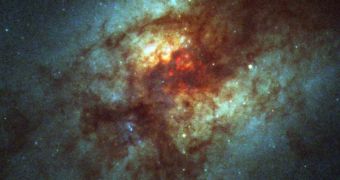We know organic molecules are scattered throughout most of the Milky Way, but it was about the time for the astronomers to find some in distant galaxies. Located at about 250 million light years away in the Serpens constellation, the Arp 220 galaxy is actually the result of the collision between two separate galaxies, which determined a massive star formation process.
Observations have shown that the Arp 220 galaxy has a collection of about 200 massive star clusters in its center and some of the heaviest of them might actually contain a quantity of material larger than 10 million solar mases.
The Arecibo Radio Telescope - currently the largest in the world, having a record diameter of 300 meters, located in Puerto Rico and operated by the Cornell University - was able to detect, through spectroscopic methods, the presence of organic molecules such as methanide and hydrogen cyanide, just two of the organic substances essential for life.
I am not a chemist to confirm it, but Robert Minchin, one of the astronomers at Arecibo, stated that these particular substances, when mixed with water, determine a chemical reaction that leads to the formation of one of the simplest aminoacids - glycine, a key component in the apparition of life on Earth.
The Arecibo Radio Telescope received last year its first paint job in more than four decades. During this time it was also upgraded with new radio receivers, capable of working in the 800 megahertz wide-band mode, which is primarily used to make spectroscopic analysis. As probably most of you know, different chemical substances and elements emit light at different frequencies. This enables astronomers to create a detailed image of the chemical composition of a distant object, studying the light it emits or reflects.
Not only organic molecules have been found in Arp 220, but it seems they also represent a rather large proportion of the matter observed in the respective galaxy, meaning the creation of such substances must have been somehow triggered by the increased star formation process.

 14 DAY TRIAL //
14 DAY TRIAL //